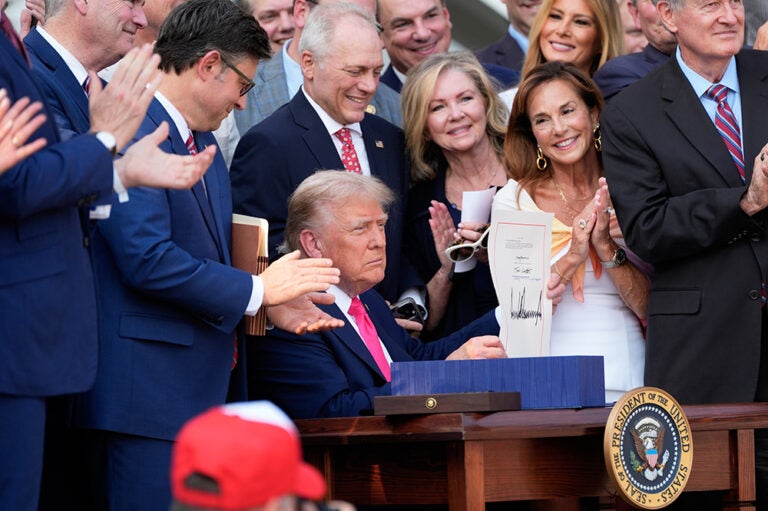Positions on whether the Constitution should be amended to require a balanced budget reflect opposing views about whether such an amendment would be an appropriate solution to the problem of persistent federal deficits and growing federal debt.
- Proponents of a constitutional amendment hold the view that future generations have a right to be protected from debts accumulated by earlier generations. Because the Congress and President are unwilling or unable to rein in the debt through normal legislative procedures, they argue that only a constitutional constraint will be strong enough to rein in lawmakers' tendency to act in fiscally irresponsible ways.
- Opponents to a constitutional amendment argue that it could limit the ability of future policymakers to use fiscal policy to counteract recessions or respond to national emergencies. Moreover, they argue that the cause of our fiscal imbalances is a lack of political will, not an inadequate process. That means that a balanced budget amendment would fail to achieve its objectives. Policymakers would look for ways to evade its restrictions and, in the process, could end up devaluing our Constitution and disrupting federal budgeting and policymaking.
What Is a Balanced Budget Amendment?
In its simplest form, a balanced budget amendment would add a budget rule to the Constitution that would require federal spending not to exceed federal receipts. The amendment would make it unconstitutional for the federal government to run annual budget deficits.
Most amendment proposals go further than requiring a balanced budget or budget surpluses. Some of the most frequent additional elements are:
- A requirement that the President submit a balanced budget to the Congress;
- Provisions that allow some flexibility in times of war or economic recession provided that a supermajority (typically three-fifths) of the members of the Congress vote in favor of a waiver;
- A provision requiring a supermajority vote of both houses of Congress in order to raise the debt ceiling;
- A cap on total spending (as a percentage of gross domestic product or GDP) unless waived by a supermajority of both houses;
- A limit on the total level of revenues (as a percentage of GDP) unless waived by a supermajority of both houses;
- A provision to prevent the courts from enforcing the amendment through tax increases;
- A provision assigning the Congress the responsibility to enforce the amendment through legislation.
How Would a Balanced Budget Amendment Work in Practice?
Supporters of a balanced budget amendment argue that respect for the Constitution will create strong political pressure to rein in deficits and impose needed accountability for irresponsible fiscal policy. Because few elected officials would be willing to face constituents with a budget that violates the Constitution, opposing parties would be forced to compromise and pass legislation that would meet the constitutional requirement.
Opponents argue that the political pressure could lead to budget gimmicks that would meet the letter, but not the spirit, of the law. Opponents also contend that it could hamper the ability of the federal government to respond quickly and effectively to economic recessions and national emergencies.
In evaluating a balanced budget amendment, there are four types of practical questions that policy makers and the public should consider.
- First, how would the use of estimates of outlays and revenues affect federal budgeting? Nearly every balanced budget amendment allows the Congress to use estimates of outlays and receipts to plan for the next year's budget. But there has been little discussion about what would happen when actual budgetary outcomes differ from the estimates, as they always do. Would there be a "look-back" provision to make up for unexpected deficits in prior years through automatic, across-the-board cuts in current-year spending? If so, the remedy could be disruptive to government's performance if resources are withdrawn without allowing agencies sufficient time to plan. Or, would the amendment only require that the lawmakers adopt a balanced budget and allow them to ignore any deficits that actually resulted? If that happened, lawmakers would face big incentives for adopting rosy assumptions when enacting budget legislation.
- Second, what role would the courts play in resolving budgetary disputes? Who would have the legal standing to challenge the failure of the Congress and President to pass a balanced budget? Would the courts' involvement lead to judicial micromanagement of the nation's fiscal affairs?
- Third, what would happen if there were not enough votes to waive the balanced budget amendment during a recession (assuming such a waiver provision existed), or if the President vetoed the waiver legislation that the Congress passed? Tightening fiscal policy during an economic downturn could make a recession worse and disrupt the flow of benefits to our most vulnerable citizens at a time when the economy was the weakest.
- Fourth, would a balanced budget amendment create incentives for policymakers to use dubious accounting and budget gimmicks to overcome the difficulties of meeting the budgetary requirements? If so, how would the use of those gimmicks affect the public's perception of the integrity, transparency and credibility of the federal budget?
Conclusion
A constitutional amendment to require a balanced budget is one approach to controlling America's deficits and debt. It would focus on the "bottom line." However, that bottom line is the product of a set of complex accounting rules designed to capture the end result of a legislative process that involves many points of view about government's role and, within those roles, the nation's priorities. Deficits and debt arise in large part from the failure to achieve consensus about those issues. By itself, the amendment cannot resolve these underlying policy differences.
Although a balanced budget amendment could set a standard that elected officials would not want to miss, there are also legitimate concerns about how it would operate in practice.
Image Credit: Getty Images
Further Reading
How Did the One Big Beautiful Bill Act Affect Federal Spending?
Overall, the OBBBA adds significantly to the nation’s debt, but the act contains net spending cuts that lessen that impact.
What Is the Disaster Relief Fund?
Natural disasters are becoming increasingly frequent, endangering lives and extracting a significant fiscal and economic cost.
How Much Does the Government Spend on International Affairs?
Federal spending for international affairs, which supports American diplomacy and development aid, is a small portion of the U.S. budget.


